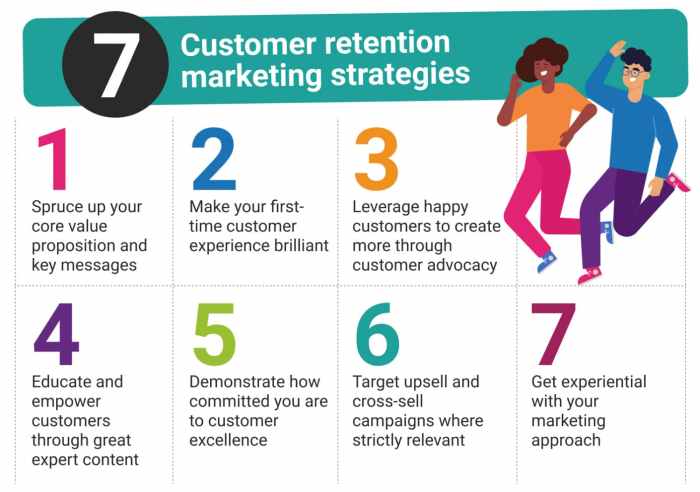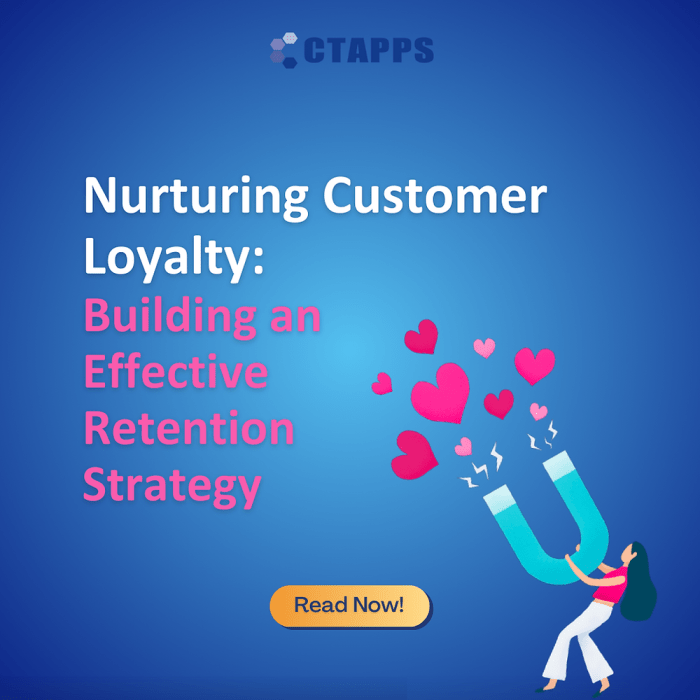Building a Customer Retention Strategy dives into the core elements of retaining customers, exploring the vital role it plays in business success and how to implement effective strategies for long-term growth.
Introduction to Customer Retention Strategy

Customer retention strategy involves the tactics and methods a business uses to keep existing customers engaged, satisfied, and loyal to the brand. It is essential for businesses as it helps in building long-term relationships with customers, increasing customer lifetime value, and ultimately boosting revenue.
Benefits of a Solid Customer Retention Strategy
- Increased customer loyalty and trust in the brand.
- Higher customer lifetime value and repeat purchases.
- Cost-effectiveness compared to acquiring new customers.
- Word-of-mouth marketing through satisfied customers.
Examples of Successful Companies with Effective Retention Strategies
- Amazon: Offers personalized recommendations and fast shipping through Amazon Prime, keeping customers coming back.
- Starbucks: Rewards program and mobile app engagement drive customer loyalty and repeat visits.
- Apple: Focuses on product quality, customer service, and user experience to retain a loyal customer base.
Difference Between Customer Retention and Acquisition Strategies
Customer retention strategies aim to keep existing customers engaged and satisfied, focusing on building long-term relationships. In contrast, customer acquisition strategies are geared towards attracting new customers to the business through marketing campaigns, promotions, and other tactics.
Understanding Customer Behavior: Building A Customer Retention Strategy

When it comes to building a successful customer retention strategy, understanding customer behavior is crucial. By analyzing various factors that influence customer loyalty and retention, businesses can tailor their approach to keep customers coming back.
Customer segmentation plays a key role in developing a retention strategy as it allows businesses to categorize customers based on their behavior, preferences, and needs. This segmentation helps in creating personalized experiences and targeted marketing efforts to increase customer satisfaction and loyalty.
Importance of Customer Segmentation
- Segmenting customers based on demographics, behavior, or purchase history can help businesses identify high-value customers who are more likely to stay loyal.
- Personalizing communication and offers for different customer segments can lead to higher engagement and retention rates.
- Understanding the unique needs and preferences of each customer segment can help businesses tailor their products or services to better meet customer expectations.
Utilizing Customer Feedback and Data Analysis
- Customer feedback provides valuable insights into customer satisfaction levels, preferences, and pain points, helping businesses identify areas for improvement.
- Data analysis allows businesses to track customer behavior patterns, predict future trends, and make informed decisions to enhance the overall customer experience.
- Combining customer feedback with data analysis enables businesses to gain a comprehensive understanding of customer behavior and sentiment to drive retention strategies effectively.
Examples of Customer Behavior Insights
- Amazon utilizes customer purchase history and browsing behavior to recommend personalized product suggestions, increasing repeat purchases and customer loyalty.
- Netflix analyzes viewer preferences and viewing habits to recommend tailored content, leading to higher user engagement and reduced churn rates.
- Starbucks uses its loyalty program data to offer personalized rewards and promotions based on customer behavior, driving increased visits and spending from loyal customers.
Building Blocks of a Customer Retention Strategy
Building a successful customer retention strategy involves several key components that are essential for maintaining customer loyalty and repeat business. One of the crucial elements is providing personalized customer experiences that cater to the individual needs and preferences of each customer. This helps in creating a strong emotional connection with the customers, making them more likely to stay loyal to your brand.
Role of Personalized Customer Experiences
Personalization plays a significant role in customer retention as it shows that you value each customer as an individual. By tailoring your products or services to meet their specific needs, you can enhance their overall experience and build a stronger relationship with them.
- Utilize data analytics to understand customer preferences and behavior.
- Offer personalized recommendations based on past purchases or interactions.
- Send targeted promotions or discounts that are relevant to each customer.
Significance of Customer Engagement and Relationship Building
Customer engagement is crucial for building long-term relationships with your customers and fostering loyalty. By engaging with customers on a regular basis and providing exceptional customer service, you can create a positive experience that encourages them to continue doing business with you.
Building a strong relationship with your customers can lead to increased customer lifetime value and positive word-of-mouth referrals.
- Interact with customers through social media, email campaigns, and personalized communications.
- Solicit feedback and respond to customer inquiries promptly to show that you value their input.
- Create loyalty programs or exclusive offers to reward repeat customers and encourage continued engagement.
Tips on Utilizing Technology for Customer Retention
Technology can be a powerful tool for improving customer retention efforts by providing more personalized and efficient services to your customers. By leveraging technology, you can streamline processes, gather valuable customer data, and enhance the overall customer experience.
- Implement a customer relationship management (CRM) system to track customer interactions and preferences.
- Use automation tools to send personalized messages and follow-ups to customers.
- Utilize data analytics to gain insights into customer behavior and preferences for targeted marketing campaigns.
Implementing a Customer Retention Strategy
When it comes to implementing a customer retention strategy, there are several key steps to follow in order to ensure success and maximize customer loyalty.
Setting Measurable Goals and KPIs, Building a Customer Retention Strategy
Before diving into implementing a customer retention strategy, it is crucial to establish clear and measurable goals. These goals will serve as benchmarks to track progress and success over time. Key Performance Indicators (KPIs) should also be defined to measure the effectiveness of the strategy.
- Identify specific retention targets based on customer segments or cohorts.
- Establish metrics such as customer lifetime value, churn rate, and repeat purchase rate.
- Regularly analyze and report on KPIs to make data-driven decisions.
Tools and Technologies for Support
Utilizing the right tools and technologies can greatly enhance the effectiveness of a customer retention strategy. Here are some examples:
- Customer Relationship Management (CRM) software: Allows for centralized customer data management and personalized communication.
- Marketing Automation platforms: Automate personalized messages and campaigns based on customer behavior.
- Customer Feedback tools: Gather insights through surveys, reviews, and feedback to continuously improve retention efforts.
Monitoring and Optimizing Retention Strategy
Monitoring and optimizing a retention strategy is an ongoing process that requires constant evaluation and adjustment. Here are some best practices to follow:
-
Regularly track and analyze customer engagement and satisfaction metrics.
- Segment customers based on behavior and preferences to tailor retention efforts.
- Implement A/B testing to optimize communication and offers for better results.





